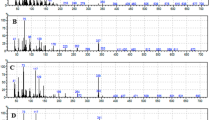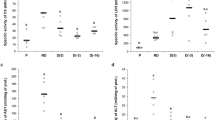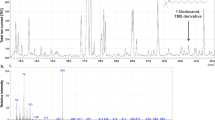Abstract
VARIOUS workers have shown the presence of some or all of the enzymes of the tricarboxylic acid cycle in insect muscle sarcosomes (for example, in Musca domestica 1, Phormia regina 2, Apis mellifera 3) or in participate fractions prepared from whole insects (for example, from Aedes aegypti 4); but other specific insect tissues have received little attention. The insect fat body is often one of the most conspicuous organs and is known to carry out many reactions involving nitrogen metabolism5; but almost nothing has been recorded of other oxidative capabilities. As the biochemical function of the fat body is probably not primarily concerned with energy production (unlike muscle sarcosomes), it appeared of interest to examine this tissue.
This is a preview of subscription content, access via your institution
Access options
Subscribe to this journal
Receive 51 print issues and online access
$199.00 per year
only $3.90 per issue
Buy this article
- Purchase on Springer Link
- Instant access to full article PDF
Prices may be subject to local taxes which are calculated during checkout
Similar content being viewed by others
References
Sacktor, B., Arch. Biochem. Biophys., 45, 349 (1953).
Lewis, S. E., and Slater, E. C., Biochem. J., 58, 207 (1954).
Hoskins, D. D., Cheldelin, V. H., and Newburgh, R. V., J. Gen. Physiol., 39, 705 (1956).
Gonda, O., Traub, A., and Avi-dor, Y., Biochem. J., 67, 487 (1957).
Kilby, B. A., and Neville, E., J. Exp. Biol., 34, 276 (1957).
Author information
Authors and Affiliations
Rights and permissions
About this article
Cite this article
HEARFIELD, D., KILBY, B. Enzymes of the Tricarboxylic Acid Cycle and Cytochrome Oxidase in the Fat Body of the Desert Locust. Nature 181, 546–547 (1958). https://doi.org/10.1038/181546b0
Issue Date:
DOI: https://doi.org/10.1038/181546b0
This article is cited by
-
Bifunctional antibody and copper-based metal-organic framework nanocomposites for colorimetric α-fetoprotein sensing
Microchimica Acta (2020)
-
Activity of Isocitric Dehydrogenase in the Fat Bodies of the Cockroach, Leucophaea maderae (F)
Nature (1967)
-
Beziehungen zwischen Fettk�rper, Oenocyten und Wachsdr�senentwicklung bei Apis mellifica L.
Zeitschrift f�r Zellforschung und Mikroskopische Anatomie (1964)
Comments
By submitting a comment you agree to abide by our Terms and Community Guidelines. If you find something abusive or that does not comply with our terms or guidelines please flag it as inappropriate.



